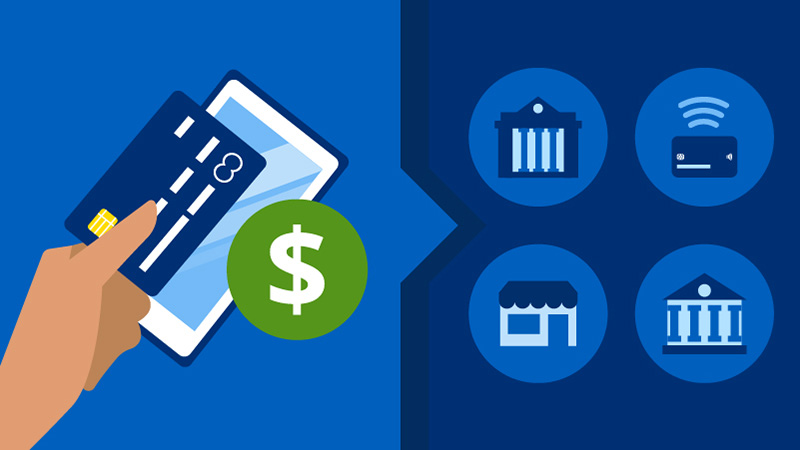When I first started helping a friend run her small business, I thought taking payments would be easy. You swipe a card, and boom—money in the bank, right? Turns out, there’s a lot more happening behind the scenes. From point-of-sale terminals to online gateways, payment processing is a whole system—and it’s the lifeblood of any business.
If you run a business or are just curious about what happens after you tap your card or click “Pay Now,” this guide will walk you through the key parts of how businesses handle money transactions.
💳 What Is Payment Processing?

Payment processing is the system businesses use to accept, authorize, and transfer money from a customer to the merchant’s account. It can happen:
-
In-person (POS systems, card readers)
-
Online (ecommerce checkouts)
-
Via mobile apps or recurring billing systems
It sounds simple, but there are multiple players and steps involved to make the transaction secure, fast, and reliable.
🔄 How Payment Processing Works (Step-by-Step)
Let’s say a customer makes a purchase with a credit card—here’s what happens in just a few seconds:
1. 🛍️ The Customer Pays
They swipe, tap, dip, or input card details.
2. 💻 The Payment Gateway Collects the Info
This is the software that securely captures and encrypts card data, especially important in online transactions.
3. 🏦 The Payment Processor Sends the Request
The processor routes the transaction info to the correct:
-
Card network (Visa, Mastercard, AmEx, etc.)
-
Issuing bank (the customer’s bank)
4. ✅ The Bank Approves or Declines the Charge
If the bank approves the transaction, it sends a confirmation back through the processor.
5. 💸 The Funds Are Settled
The processor sends the money to the business’s merchant account, minus any fees.
All this happens in 2–5 seconds, usually without the customer noticing. But behind the scenes? It’s a carefully choreographed financial dance.
🧩 Key Players in Payment Processing
To really understand how it works, it helps to know who’s involved:
-
Customer – the person making the purchase
-
Merchant – the business selling the product or service
-
Payment gateway – the secure front-end tech (for online sales)
-
Payment processor – the middleman who routes payment info
-
Card network – Visa, Mastercard, etc., which approve the transaction
-
Issuing bank – the customer’s bank
-
Merchant account – where the funds are deposited
Each party takes a small cut through processing fees, usually a few percent of each sale.
🛠️ Types of Payment Systems for Businesses
Depending on the type of business, payment systems can look very different. Here are the main options:
1. 🏪 In-Person (Point of Sale / POS)
Ideal for brick-and-mortar stores:
-
Use card readers, terminals, or full POS systems
-
Can also accept mobile wallets (Apple Pay, Google Pay)
-
Often integrated with inventory and sales tracking
Popular options: Square, Clover, Toast (for restaurants)
2. 🛒 Online Payment Gateways
Essential for ecommerce:
-
Embed payment forms in your website
-
Accept credit cards, PayPal, and digital wallets
-
Require SSL security and PCI compliance
Popular options: Stripe, PayPal, Shopify Payments, WooCommerce
3. 📱 Mobile and App-Based Payments
Great for freelancers, food trucks, and service-based businesses:
-
Accept payments via phone or tablet
-
Send invoices or payment links
Popular options: Venmo Business, Zelle, Square Reader, QuickBooks Payments
4. 🔁 Recurring or Subscription Billing
Used for memberships, SaaS, or monthly services:
-
Automate payments
-
Handle invoices, failed payments, and customer updates
Popular tools: Recurly, Chargebee, Stripe Subscriptions, GoCardless
💳 Fees, Fraud, and Compliance (The Less Fun But Important Stuff)
Let’s be honest: payment processing isn’t free. Here’s what you need to know:
⚠️ Processing Fees
Most platforms charge:
-
2.5–3.5% per transaction, plus a small fixed fee
-
Extra for international or “card not present” transactions
⚠️ Chargebacks
If a customer disputes a charge, the business might get hit with:
-
Lost revenue
-
A chargeback fee
-
Potential investigation
✅ PCI Compliance
If you store or process cardholder data, you must meet security standards to prevent fraud. Most modern platforms help with this automatically, but you should still:
-
Use SSL encryption
-
Avoid storing sensitive data
-
Train staff on secure payment practices
📊 Choosing the Right Payment Processor
When picking a system, ask:
-
What’s the fee structure? (flat vs. tiered rates)
-
Does it integrate with your existing tools?
-
How fast are payouts? (Some pay next-day, others in 3–5 days)
-
Does it support multiple payment types?
-
How is the customer support?
Don’t just go with the cheapest—go with what fits your business model.
🧭 Final Thoughts: Payment Processing Is the Heart of Modern Business
Whether you’re a solo entrepreneur, a growing ecommerce store, or a local shop owner, payment processing is one of the most critical systems in your business. It’s how you get paid. It’s how you build trust. And it’s what makes commerce possible in a cash-light world.
The good news? There are tons of tools available, even for beginners. Just take the time to understand what’s happening behind the scenes—so you can make smart, secure choices that grow with your business.
Discover the art of great food and unforgettable gatherings at Decology – your go-to guide for dining and entertainment. – https://decology.com
